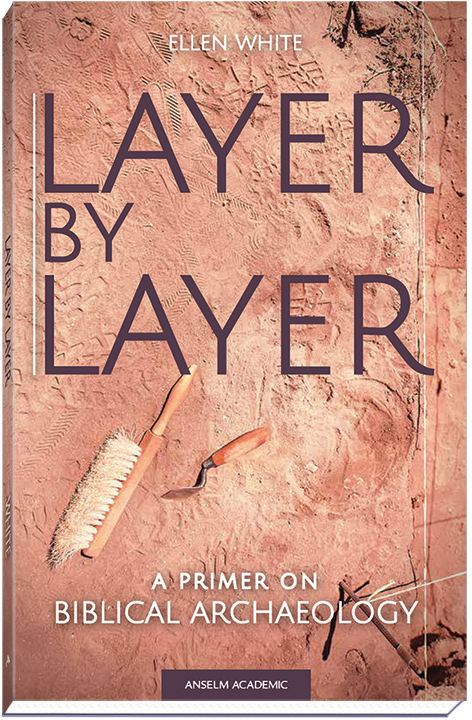Layer by Layer
A Primer on Biblical Archaeology
About This Book
Overview
Tracing its history from an independent discipline under the umbrella of archaeology to an interdisciplinary dialogue between archaeology and biblical studies, Layer by Layer: A Primer on Biblical Archaeology explores what biblical archaeology was when it began 200 years ago, why it became controversial, and what it is today. Ellen White offers a compelling case for the dialogue between archaeology and biblical studies by introducing the methodology and goals of each discipline and demonstrating the mutual benefit of their relationship. With a glossary, study questions, recommendations for additional reading, and dozens of images, graphs, and maps, Layer by Layer successfully equips students—regardless of background or familiarity with this subject—to understand this exciting field.
Details
| Weight | .25 lbs |
|---|---|
| Dimensions | 5.375 × .5 × 8.25 in |
| Print ISBN | 978-1-59982-959-3 |
| Format | Softcover |
| Pages | 120 |
| Item # | 7088 |
|---|
Customer Reviews
Layer by Layer is an excellent companion to courses in either biblical studies or archaeology, introducing students of both disciplines to methodology used by their colleagues that will benefit their own studies. Ellen White draws upon her own experiences to vividly and candidly describe what it is like to do archaeological fieldwork and what such work has contributed to answering some of the major questions posed by the Bible. The book’s lively, engaging, and humorous style makes reading enjoyable for both students and instructors.
One could scarcely hope for a more helpful introduction to biblical archaeology, a field subject to much sensationalism and misunderstanding. Ellen White explains what archaeologists really do and how their work relates to biblical studies. Her clear writing and judicious examples will engage students and laypeople alike. I foresee lots of students signing up for summer digs.
Layer by Layer is a helpful and engaging primer on the intersection of archaeology and biblical studies. Pictures, charts, and pop culture references will engage students while providing professors plenty of resources for the classroom. Ellen White makes a convincing case that the disciplines of archaeology and biblical studies are stronger when in dialogue. Layer by Layer not only introduces the methods of archaeology, but also explores the basics of biblical exegesis. Respect for both disciplines is evident throughout the book and the final chapter ably demonstrates the advantages biblical archaeology provides by considering the origins of Israel.
Romantic, controversial, myth-making, myth-breaking. Ellen White’s introduction opens a window onto the fascinating world of biblical archaeology and some of its most famous proponents. Every reader will have their appetite whetted for more.
Ellen White’s Layer by Layer is lively, informative, and accessible. Reading it is like sitting in on a lecture with your favorite professor, who keeps the class engaged with well-chosen examples, anecdotes, and slides. These features keep the book grounded in the concrete realities of archaeology and biblical studies, and they also help build the case White is making for a partnership between the two disciplines. As she demonstrates in her final chapter, both are foundational for interpreting biblical texts. White’s experience in both disciplines makes her an ideal guide and a model of the scholarly approach she advocates.
Table of Contents
Preface
Chapter 1: Mythbusters
Chapter 2: The Bible and the Spade
Chapter 3: Archaeology 101
Chapter 4: Engaging Exegesis
Chapter 5: Biblical Exegesis and Archaeology: Stronger Together
Glossary of Terms
Index
Professional Reviews
Layer by Layer: A Primer on Biblical Archaeology
Ellen White has produced a helpful survey of biblical archaeology as a result of her years immersed in the discipline as a university professor, editor, and archaeologist. She has written Layer by Layer: A Primer on Biblical Archaeology to introduce her readers to the often-misunderstood field where biblical studies and archaeology intersect.
In five chapters, White corrects misconceptions and clarifies what biblical archaeology is and is not; she surveys the methodologies of archaeology and biblical studies and concludes with a test case to demonstrate how the two disciplines relate. It is an accessible introduction with plenty of interesting examples and clear explanations. Review and discussion questions are included at the end of each chapter along with recommended reading for further study. Key terms are defined, there is a helpful glossary in the back, and it is short too—just over 100 pages. And yet for having such a short length, it packs significant value within its narrow binding by fulfilling White’s intent to inform.
Readers will quickly find that biblical archaeology is not a silver bullet that has the power to unquestionably prove or disprove the historical accounts recorded in Scripture. Nor should we mistakenly consider archaeology a pure science. It requires a great deal of interpretive art to best account for the data.
Another helpful clarification, according to White, is that biblical archaeology is not concerned with uncovering newsworthy material. In fact, it is almost entirely focused on understanding how daily life looked in the past, she writes. There is a high degree of agreement in all of these areas mentioned so far, but readers may be surprised to learn that there is still disagreement over the seemingly simple question of what biblical archaeology is. There is a longstanding tension between the “biblical” side and the “archaeology” side. And the history of biblical archaeology provided in chapter 2, “The Bible and the Spade,” demonstrates how this debate is ongoing. Proponents on one side have called for total secularization, while proponents on the other side have sensationalized claims and ignored findings that have not met their purposes. So what is biblical archaeology? White, attempting to strike a balance, calls biblical archaeology “an interdisciplinary endeavor that takes place in the intersection between biblical studies and the various subdisciplines of archaeology” (37).
For such a short book, it could arguably have been even shorter if an extraneous and unneeded chapter on biblical exegesis was omitted or at least shortened. I understand the author wants to foster a dialogue between archaeology and exegesis, but including a fairly elaborate manual on exegesis via chapter 4, “Engaging Exegesis,” is not necessary. White walks readers through the standard “world of the text,” “world behind the text,” and “world in front of the text” in an overly detailed manner.
As a result, students may lose sight of the book’s purpose when they have to read explanations of specialized exegetical considerations such as literary features and textual criticism. White views the historical-critical method as the preferred approach to interpreting Scripture. In her estimation, the Bible has a theological purpose that does not necessitate historical accuracy when it speaks to the events it describes. Thus, it follows that she is openly biased in her view that one interprets Scripture by looking through the lens of archaeology. When there is an incompatibility between text and archaeological data, White doesn’t allow the Bible to take primacy over the spade.
Without a doubt, archaeological insights can aid our interpretation of Scripture and vice versa. But for White, biblical studies and archaeology are engaged as equals in an “intricate dance” (101). Whether you agree or disagree, there is value to considering this relationship further, and I am glad she has raised the question.
In a culture where our primary exposure to archaeology is through fedora wearing, whip-wielding adventurers, building up from the basics is a wise approach. This book successfully achieves its purpose of introducing readers to biblical archaeology. It would work well as a supplemental textbook in a course on biblical studies. Interested readers will likely find themselves itching to join an archaeological dig.
Date of Review:
ELLEN WHITE, Layer by Layer: A Primer on Biblical Archaeology (Winona, MN: Anselm Academic, 2019, paper $19.95) 120pp. 2 figs., 17 halftone, 4 maps, 2 tables, Indexed. ISBN: 978-1-59982-959-3.
Noting that “biblical archaeology” is neither a subdiscipline of archaeology nor an independent discipline in its own right but a field of study that occupies the intersection between the two disciplines of archaeology and biblical studies, this introductory textbook on biblical archaeology aims to be accessible to beginning students of both disciplines. After a three-page preface, it first addresses common “myths” surrounding biblical archaeology and separates fact from fiction. Next it defines biblical archaeology in the 21st century, describes the history of the term, and explores why this phrase became controversial and why it remains so for some scholars. Then it introduces the basic methods of both archaeology and biblical studies, respectively. Finally, it explores the benefits of dialogue between these disciplines through an extended example that is still an open and evolving question in both fields: three different models for the origins of ancient Israel (the conquest model, the peaceful infiltration mode, and the peasant revolt or resettlement model). A seven-page glossary is included. White was previously senior editor at the Biblical Archaeology Society.
Boston College School of Theology and Ministry
Ellen White. Layer by Layer: A Primer on Biblical Archaeology. Winona, MN: Anselm Academic (www.anselmacademic.org), 2019. Pages, 120. Paper $19.95.
The Bible Today
This useful little primer offers the beginning Bible student an accessible, informative introduction to the nature and value of archaeology for biblical studies. The author, who has a doctorate in Hebrew Bible from the University of St. Michael’s College (Toronto), has both theoretical knowledge and practical experience in the field. The first chapter, called “Mythbusters,” addresses common misconceptions about archaeology and its relationship to biblical studies (e.g., Myth #6: Archaeology Disproves the Bible). The subsequent chapters offer a historical overview of “biblical archaeology,” lessons in Archaeology 101, a presentation of exegesis, and a discussion of how exegesis and archaeology can be mutually enriching. Each chapter ends with review and discussion questions, a list of key terms, and a short selection for further reading. All of this, plus a glossary at the end, makes this a valuable resource for the classroom or personal study.



